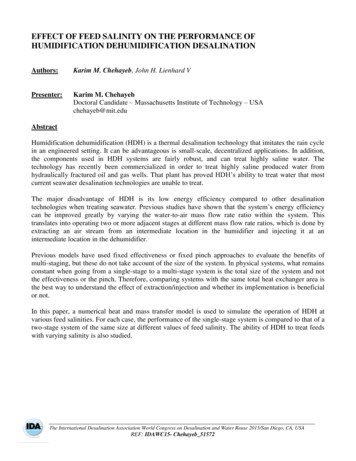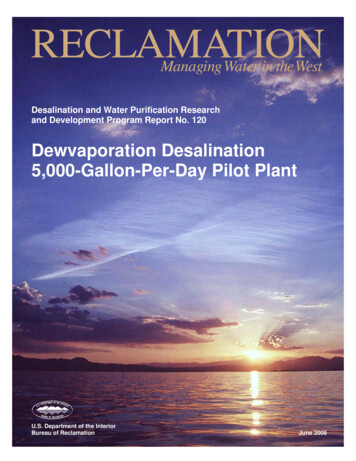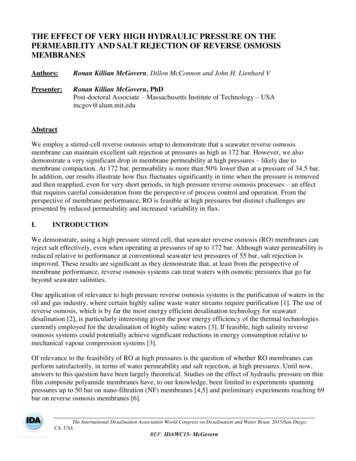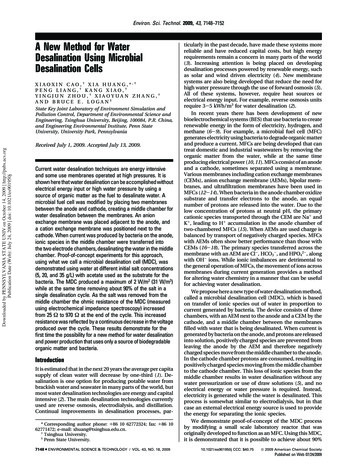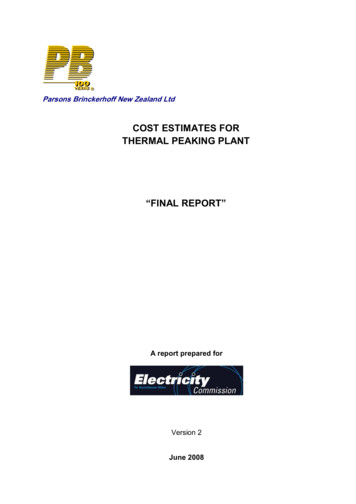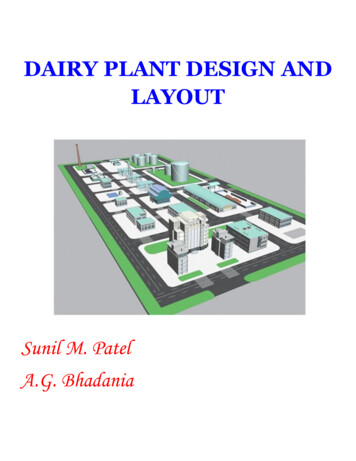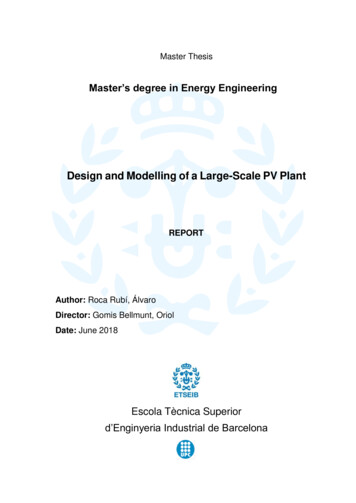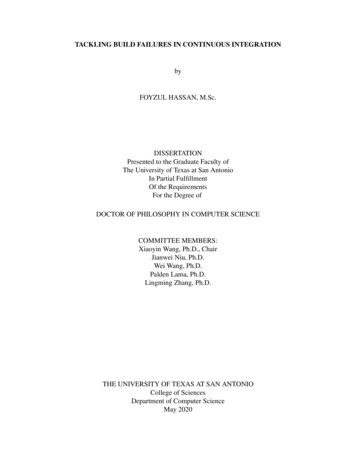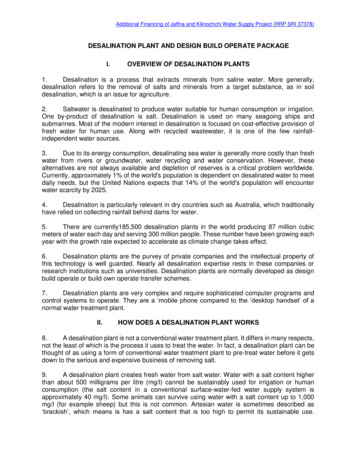
Transcription
Additional Financing of Jaffna and Kilinochchi Water Supply Project (RRP SRI 37378)DESALINATION PLANT AND DESIGN BUILD OPERATE PACKAGEI.OVERVIEW OF DESALINATION PLANTS1.Desalination is a process that extracts minerals from saline water. More generally,desalination refers to the removal of salts and minerals from a target substance, as in soildesalination, which is an issue for agriculture.2.Saltwater is desalinated to produce water suitable for human consumption or irrigation.One by-product of desalination is salt. Desalination is used on many seagoing ships andsubmarines. Most of the modern interest in desalination is focused on cost-effective provision offresh water for human use. Along with recycled wastewater, it is one of the few rainfallindependent water sources.3.Due to its energy consumption, desalinating sea water is generally more costly than freshwater from rivers or groundwater, water recycling and water conservation. However, thesealternatives are not always available and depletion of reserves is a critical problem worldwide.Currently, approximately 1% of the world's population is dependent on desalinated water to meetdaily needs, but the United Nations expects that 14% of the world's population will encounterwater scarcity by 2025.4.Desalination is particularly relevant in dry countries such as Australia, which traditionallyhave relied on collecting rainfall behind dams for water.5.There are currently185,500 desalination plants in the world producing 87 million cubicmeters of water each day and serving 300 million people. These number have been growing eachyear with the growth rate expected to accelerate as climate change takes effect.6.Desalination plants are the purvey of private companies and the intellectual property ofthis technology is well guarded. Nearly all desalination expertise rests in these companies orresearch institutions such as universities. Desalination plants are normally developed as designbuild operate or build own operate transfer schemes.7.Desalination plants are very complex and require sophisticated computer programs andcontrol systems to operate. They are a ‘mobile phone compared to the ‘desktop handset’ of anormal water treatment plant.II.HOW DOES A DESALINATION PLANT WORKS8.A desalination plant is not a conventional water treatment plant. It differs in many respects,not the least of which is the process it uses to treat the water. In fact, a desalination plant can bethought of as using a form of conventional water treatment plant to pre-treat water before it getsdown to the serious and expensive business of removing salt.9.A desalination plant creates fresh water from salt water. Water with a salt content higherthan about 500 milligrams per litre (mg/l) cannot be sustainably used for irrigation or humanconsumption (the salt content in a conventional surface-water-fed water supply system isapproximately 40 mg/l). Some animals can survive using water with a salt content up to 1,000mg/l (for example sheep) but this is not common. Artesian water is sometimes described as‘brackish’, which means is has a salt content that is too high to permit its sustainable use.
2Seawater has a salt content of approximately 32,000 mg/l. This number varies across the planetand can range from 30,000 mg/l to 37,000 mg/l.The term mg/l is used throughout this paper and stands for ‘milligrams per litre’. It is equivalent to ‘partsper million’. A micro-meter, or ‘micron’, is 10-6 meters, or 0.000001 meters.10.A seawater desalination plant has a ‘recovery rate’ of approximately 50% to operateefficiently. This means that for every litre of water taken into a plant about half a litre of fresh wateris produced. The remaining half litre is returned to the sea carrying the entire salt load from thefull litre taken in. This means that the salt content of the returned water is approximately 64,000mg/l. Elaborate means are put in place to disperse this highly salty water into the sea as quicklyas possible. It also means that if you want to produce 1 litre of water you have to process twolitres.11.A desalination plant has five main components which are shown in the following table. Thepercentage refers to the percentage of the overall capital cost of a plant. This can vary dependingupon the topography (both land and marine), ground conditions, the distance to the coast.Table 1: Desalination Plant ComponentsIntake18%The purpose ofthe intake systemis to get theseawater fromthe sea to theplant.Pre-treatment22%The purpose ofthe pre-treatmentsystemistopreparetheseawater for thenext stage oftreatment.Treatment49%The purpose ofthetreatmentsystemistoproducewaterready for posttreatment.Post-Treatment3%The purpose oftheposttreatment systemif to prepare waterfor transfer andconsumption.The intakesystemcomprises anintake structure(locatedoffshore), anintake pumpstation (located atThepretreatment systemremoves all thesuspendedmaterial in theseawater,effectivelyconverting ‘dirty’Thetreatmentsystem removesthe salt from thesaline water andhas two outputsteams,whichare a pure waterstream and aTheposttreatment systemprepares the purewater from thetreatment systemreadyforitstransfertocustomers. TheWaste Disposal8%The purpose ofthewastedisposal systemis to prepare anddispose of disposal systemdisposes of thewaste producedfromthetreatmentprocesses. Thereare two waste
3Intake18%the treatmentplant) and anintake pipeline(connecting thetwo). Nearly all ofthe intake systemis buried.Pre-treatment22%seawaterinto‘clean’ seawater.Thepretreatment systemis really two ormore treatmentsystemsallperformingspecialisedfunctions, with theselectionbeingsolely dependentupon the qualityof the seawater.Treatment49%brinestream.There are severalavailabletechnologies forremovingsaltfrom a salinewater. By far themostenergyefficientisreverse osmosisand this is nowvery widely used.Thereverseosmosismembranes arecleaned each dayusingconcentratedsulphuricacidand biocides.To remove thesalt very highpressuresarecreatedbypumps, and thisuses a lot ofenergy(electricity).Energy recoverydevisestopreventtheenergybeingwasted after thetreatmentprocess is hasbeen completed.Post-Treatment3%water producedfrom a reverseosmosis systemis very pure, andpure water is avery aggressiveliquid. If not posttreated it woulddestroy pipelinesand would beharmfultoconsumers.Chemicals(normallylimewhich is calciumcarbonate)areadded to the purewater to make itsuitablefortransfer and use.Chlorine is alsoadded to ensurethe water remainssafefromcontamination.Waste Disposal8%streams, namelyliquid waste andsolid waste. Theliquidwastestream comprisesthe brine solution,chemicals used tokeepallthetreatmentsystemscleanand any liquidwastes from thepre-treatmentsystem.Theseare all treated in atank and thensent back to theocean though anoutfallpipelineand diffuser. Thesolidwastestream comprisessludges from thepre-treatmentprocess and thespent filter mediaand membranes.The solid waste issent to a landfill.12.The above table shows that successive treatment processes are used to removed smallerand smaller particles from a liquid until the final ‘filter’ (reverse osmosis) removes particles at themolecular level.13.are:There are two other important components associated with a desalination plant. These(i)(ii)Providing an adequate supply of electricity to the desalination plant site(desalination plants use a lot of energy to create the high pressures they need tofunction; andTransferring the water from the desalination plant to a suitable connection point inthe water supply network. Sometimes very long and expensive pipelines and pumpstations are needed.
414.Both can add substantially to the cost of a desalination plant.15.It takes a lot of energy to remove salt from water (regardless of the technology – forexample boiling water and capturing the steam as fresh water) and much research has been, andcontinues to be, put into improving the efficiency of the reverse osmosis process. Unfortunately,the laws of physics place a limit on just how efficient the process can become. Efficiency gainswill continue to be made, but these are likely to be only small gains in the future, rather than thelarge gains that have been achieved historically.16.The following figure shows the range for different filters and what they remove.Microfiltration and ultrafiltration are sometimes used as a pre-treatment for hyperfiltration (reverseosmosis) in desalination plants. Note that hyperfiltration membranes will remove bacteria, virusesand heavy metals which is a considerable benefit.Figure 1: FiltrationIII.WHEN IS A DESALINTION PLANT THE BEST OPTION17.Throughout history usable water has been obtained from the ground (wells and bores),the surface (rivers and lakes) and the air (rain and snow). All these sources are suffering fromoveruse and the encroachment of contamination resulting from man’s exploitation of theenvironment. The severity of this problem is being rapidly exacerbated by climate change. Anincreasing population together with urbanisation, and a reduction in arable areas due to the lossof surface soil also contribute to the water problem.18.Fortunately, with affordable desalination now available there is a new and limitlessresource in the ocean (the world’s oceans hold about 96.5% of the earth’s water). That is, at leastas long as you live near the sea (most of the world’s biggest cities are on or near the coast).Desalination water is expensive water (compared to traditional supplies) but is now being used to
5grow crops in the Middle East and Spain. In Australia where the climate is very variable each ofthe major cities has invested in a large desalination plant as an insurance against reducingrainfalls and long periods of drought.19.It is this concept of desalination plants providing a guaranteed source of usable water thatcan tide cities over during droughts that is their strength. Cities now have the option of divertingwater more and more water from hinterlands, or leaving that water for food production andproducing their own water from the sea. Generally, cities are wealthy compared to rural areas andcan afford this technology.20.Another advantage of desalination, particularly in cities where the users of water pay forthe water on a volumetric basis, is that its higher cost encourages both water conservation andwater reuse.21.Finally, as demonstrated in the figure above, the desalination process removes allcontaminates from the water including bacteria and viruses resulting in a water that is healthy andfit for sustained human consumption. For example, a desalination plant will remove fluorinepreventing skeletal fluorosis. Although these health benefits are not costed into the businesscases for desalination plants they are very material.22.So, when is a desalination plant the best option? The answer is when any of the followingapply:(i)(ii)(iii)(iv)Where water is scarce and existing sources are either unreliable or becomingcontaminated;Where populations and urbanisation is diverting surface water away from importantagricultural needs;Where ‘future-proofing’ is required against climate change; andWhere water is needed in arid areas to grow food.Growing Food in the Desert Using Desalinated Water
6IV.WHAT ARE THE PREREQUISITES FOR A DESALINATION PLANT23.Unfortunately, desalination plants cannot be built just anywhere. Some prerequisitesapply:(i)(ii)(iii)(iv)(v)(vi)The site must be close to the open sea—if the site is in a bay or estuary the brinesteam from the plant may not be able to be dispersed resulting in an adverseenvironmental impact;The site must have access to a reliable and adequate supply of electricity—desalination plants to not take kindly to a sudden loss of power and a large amountof damage can result from an uncontrolled shutdown;The topography of the area (both land and inshore marine environment) must besuitable for the construction of the intake and outfall structures – you won’t find adesalination plant on top of a cliff;The marine environment should not be a breeding ground for aquatic animals orcontain rare sea grasses;The site should be reasonable close to the city it is to supply, and the city musthave an adequate water distribution system to transfer the desalinated water tocustomers (without losing a third of this expensive water along the way); andThere needs to sufficient funding available to support the construction of the plantand its ongoing operations and maintenance – unlike conventional treatmentplants if a desalination it not careful maintained every day it can cease to functionwithin a few days, the source of water is immediately lost and the repair costs toreturn it to supply can be very large.24.If all these boxes can be ticked then it becomes a matter of whether the water resourcesat the location need augmenting, and whether a desalination plant is the best form ofaugmentation.A Desalination Plant Built Next to an Electricity Generating Plant and the Ocean
7IV.DESIGN, BUILD AND OPERATE CONTRACTS25.As mentioned design, build and operate (DBO) or design, build, operate and financecontracts are mostly used for establishing desalination plants. The key difference is how the plantis funded. Private sector funding is usually more expensive than public sector funding (due tohigher interest rates), however is has the advantage of shifting the debt off the Government’sbalance sheet and thereby helping preserve the government’s credit rating. Private sector fundinghas lost favour in recent times due to its high establishment costs and its need for long termcontracts (25 years or more).26.Several procurement methods are used. For very large plants the alliance method ofprocurement has become popular27.A DBO, as the name implies, engages a contractor to design build and operate a plant.The minimum desirable operating period is 7 years however periods down to 3 years have beenused.28.The thinking behind a DBO contract is that the builder of an asset must operate the asset,and therefore has an incentive to do a good job in the asset’s design and construction. There issome truth in this, but the flaw is that the emphasis then shifts to the maintenance of the assetduring the operation period. The contractor only has an incentive to survive the duration of theoperation period whereas the employer wants to use the asset for a much longer term. This issuehas been addressed in some DBO contracts by offering successive extensions to the operationperiod based upon the performance of the contractor during the operation period. Regardless, aswith any form of contract, the employer must have a competent and technically well informedproject management unit to supervise the contractor to ensure it is getting what is has contractedfor.29.There are several key hold points in a DBO contract which enable the Contractor’semployer to assure itself that it is getting what it is paying for. These are at the end of design, theend of construction and after the first year of operation. It must be recognised that the employer(providing a service) and the Contractor (financial reward) have different motives and a good DBOcontract tries to balance these.
830.With a typical design and construction period of 3 years the duration of the entire contractcould be 10 years. In such a circumstance, it is critical that a large amount of care is put intodeveloping the bidding documents and contract, and the appointment of the contractor. It is a 10year relationship and a relationship that is very difficult and expensive to sever should things sour.31.The benefits of contracting include the following:(i)(ii)(iii)(iv)Contracting provide access to expertise an Employer may not have, nor can easilyof affordably purchase;Contracting permits an employer to focus on its core business and not bedistracted by matters best left to others;Contracting allows the control of costs and brings certainty to budgeting andforecasting; andContracting can supplement resources during peak work loads.32.For a desalination plant expertise is needed to both build the plant and operate the plant.If only one to two plants are held amongst many other assets (such as pipeline systems) it isquestionable whether the development of in-house and expensive expertise is warranted for sucha small part of the business.33.Looking ahead it is difficult to see any change to the use of DBO or similar contracts toprocure and operate desalination plants. There are now several international companies highlyskilled in providing this service. DBO contracts themselves will continue to evolve and there area number of improvements that can be made to cater for increasing level of sophistication ofemployers, and for local needs.V.JAFFNA DESALINATION PLANT EXPERIENCE34.The first stage of the Jaffna desalination plant will produce 24,000 cubic meters per dayof desalinated and disinfected water. The plant will be built in conjunction with a downstreamwater supply network proving a reticulated water supply to 270,000 people in Jaffna. Schematicsof the desalination plant site and the downstream pipe network are shown in the next two figures.35.The contract being used is a DBO contract with a 2.5-year design and construction periodand a 7-year operating period.36.The desalination plant site is located some 42 kilometers to the south east of Jaffna anda part of the project requires the construction of an 8-kilometer pipeline and pump station toconnect the plant to the nearest existing water supply transition pipeline. Several planning studieshave been undertaken to support the project and social and environmental safeguards have beenput in place and monitoring programs have been developed.37.The project has been advertised internationally, and market interest has been very good.
9Figure 2: Schematic of the Jaffna Desalination Plant SiteFigure 3: Schematic of Downstream Water Supply Network38.The Jaffna Desalination Project is currently being tendered, and all the portents are good.Nevertheless, there have been some lessons learned along the way and these may besummarised as follows:(i)(ii)(iii)(iv)(v)Make sure risks are correctly assigned;Make sure the bidding document fosters both competitive tendering;Make sure the bidding document utilises the expertise of the market;Make sure that the bidding document is clear on the outcomes that are beingsought and how these will be measured (a common failing of most contracts); andMake sure the bidding team has the right mix of skills and experience.39. Some examples of these lessons are contained in the following table.
10Table 2: Lessons Learnt During the BiddingRisk AssignmentThere are things that the contractor can be expected to know andcontribute, and things that the employer is best placed to know.An example of the first would be how to combine the differenttreatment systems to obtain a working plant. An example of thelatter is the quality of the raw water.It is useful to produce a table of all the information that is requiredfor a project early in the planning process and assign the items inthe table to either the employer or contractor. Where somethingis not known, it is not always satisfactory to leave it to thecontractor to find out, or worse guess. Contractors areconservative and will boost their prices accordingly.Significant events which are clearly outside the control of theemployer and contractor should be deemed to be force majeureevents and taken by the employer.There are very good guidelines for determining the qualificationcriteria for contractors and these should be followed. However,the guidelines should be applied judiciously with the parametersselected to achieve what they are meant to achieve, that is theyqualify contractors which have the experience, financial capacityand financial resources to undertake the contract.The is a temptation for an employer to get involved in the detaileddesign of a project, rather than restrict itself to the outcomesrequired and the boundary conditions that apply (social andenvironmental safeguards are one form of boundary conditions).In becoming involved an employer limits the contractor using itsfull expertise in coming up with the most efficient and practicaldesign. As with risk it is best to leave designs decisions with thosemost qualified to make them. This particularly applies todesalination plants where the technologies continue to rapidlyevolve. However, is does require the employer to be quitespecific and definition is setting down the outcomes it wants andthe boundary conditions that apply.One of the most important items to include in a bidding documentis the outcomes the contract is supposed to achieved and theways in which these outcomes will be measured. If theseoutcomes are achieved then the contract has met its purpose. Anexample the high-level project outcomes and the more detailedproject outcome for the first two high level project outcomes areshown in the following two tables.The bidding team will be a core team which has a range of skillavailable to it (mostly consultants). The core team must havegood project management experience and a knowledge of thetechnologies it is proposing to employ. For a DBO it is useful ifthe team also have operational experience.Competitive TenderingMarket ExpertiseProject OutcomesBidding TeamTable 3: High Level Project OutcomesNo.123Requirement ce Water – Quantity and QualityProvide for AugmentationProvide Buildings, Services and Amenities
11No.456Requirement TypeFunctionalManagementManagementRequirementHand Back OperationsPractise Asset ManagementPractise Project ManagementTable 4: Detailed Project Outcomes – First Two High Level Project Outcomes OnlyNo.Criterion11FunctionalRequirement:Produce Water –Quantity andQuality234562FunctionalRequirement:Provide forAugmentation123Key Factors24 MLD capacity is provided6/12/18/24 incremental supply is provided quantity95.9% quantity reliability is achievableThe specified water quality is provided6/12/18/24 incremental supply is provided –quality100% quality reliability is achievableAllowance for 24 MLD to 48 MLD capacity isprovidedAllowance for a Boron reduction from 2.4 mg/lto 1 mg/l is providedAllowance for the installation of a DAF systemis providedDAF dissolved air flotation, mg/l milligrams per liter, MLD million liters per dayVII.SUMMARY40.This paper has covered a range of topics related to desalination, contacting and the JaffnaDesalination Project. As the Jaffna project proceeds more lessons will be learned and the projectwill provide an excellent case study for possible future desalination plants. Desalination plants arehere to stay, and more are likely to be built over the coming years, with financing from multilateralbanks.41.The Jaffna project management team has been established and will update this paper asthe project proceeds to provide more insights into the procurement of desalination plants.Inside a Modern Desalination Plant
12VI.WHAT ARE OSMOSIS AND OSMOTIC PRESSURE42.Osmosis is a natural process and describes the passage of dissolved ions across a semipermeable membrane. An example of this project is the passage of chemicals through the wall ofa cell in the human body, and is essential for life. The following diagrams describe osmosis andosmotic pressure. The reason this pressure exists is complex and is related to the internal energyof the molecules in question. Suffice to say that is exists and is a major force in nature.Osmosis43.If two solutions of different concentration are separated by a semi-permeablemembrane which is permeable to the smaller solvent molecules but not to the larger solutemolecules, then the solvent will tend to diffuse across the membrane from the lessconcentrated to the more concentrated solution. This process is called osmosis.Osmotic Pressure44.The osmotic pressure is the hydrostatic pressure on the solution is required to preventthe transport of water from a pure source across a semi-permeable membrane into thesolution. A positive pressure must be exerted on the solution to prevent osmotic transport.
1345.In a desalination plant, we want the salt in seawater to leave the seawater, rather thanattract further salt to join it, as would occur in the process described above (that is, change themigration of salt from a low concentration to a high concentration to the other way around). Thisrequires a reversal of the osmotic process. To achieve this reversal, we first need to overcomethe naturally occurring osmotic pressure and then add additional pressure to drive the process inthe other direction. To create this pressure high pressure pumps are needed and lots is electricity.As the osmotic pressure is a naturally occurring process there is a limit to how efficientdesalination plants can become, as described earlier.46.One final note as this process is not to be confused with diffusion which would see twodifferent solutions mixing to become homogenous.
build operate or build own operate transfer schemes. 7. Desalination plants are very complex and require sophisticated computer programs and control systems to operate. They are a 'mobile phone compared to the 'desktop handset' of a normal water treatment plant. II. HOW DOES A DESALINATION PLANT WORKS 8.
